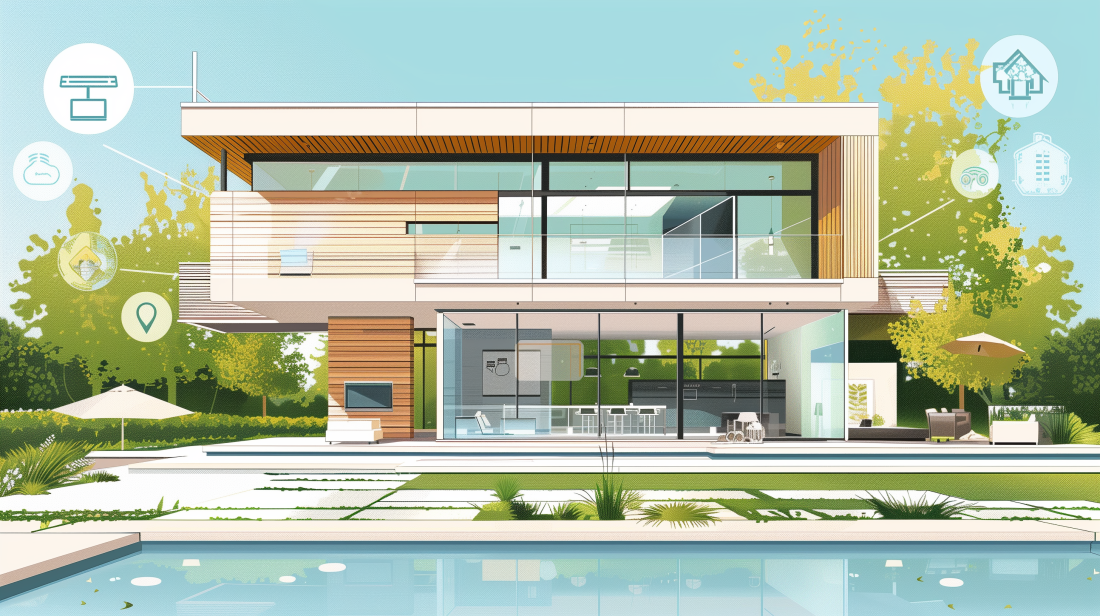Scope:
- Install window attachments in new or retrofit construction to achieve various benefits such as reducing cooling and heating energy consumption, improving comfort, reducing glare, and enhancing resistance to extreme heat events.
- Determine specific goals and priorities for improving each window in a home, including:
- Reducing solar heat gain in summer
- Reducing heat loss at night in winter
- Reducing glare
- Reducing nighttime light infiltration
- Providing noise control
- Increasing privacy
- Enhancing security
- Providing protection during high winds
- Maintaining or improving daylighting
- Maintaining views to the outside.
- Use the DOE Efficient Window Coverings website to compare attachment devices and select those that best meet your goals.
- Select interior and exterior shading attachment systems rated by the Attachments Energy Rating Council (AERC), with appropriate “Warm Climate” and “Cool Climate” performance ratings.
- Pre-wire windows for potential use of motorized and automated shading systems during construction.
- Integrate exterior and/or interior shading attachments as a new construction feature or as part of a retrofit.
Description:
Window attachments encompass a wide range of interior and exterior products that can be installed over windows, doors, or skylights in residential and commercial buildings. These attachments serve various purposes and include:
- Interior attachments: blinds, shades, screens, drapes, shutters, window quilts, and surface-applied films.
- Exterior attachments: roller shades, shutters, solar screens, and awnings.
- Both interior and exterior storm windows.
Benefits of Window Attachments
Window attachments offer numerous benefits to homeowners, including:
- Increased resistance to extreme heat events, critical if air conditioning fails or is unavailable.
- Reduced energy consumption, costs, and emissions by decreasing the load on the air conditioning system.
- Enhanced comfort, even with air conditioning, by providing shading.
- Decreased wear on the air conditioning system, resulting in less maintenance and longer equipment life.
- Effective daylighting control, reducing the need for artificial lighting and saving energy.
- Improved privacy.
- Reduced noise intrusion.
- Diminished nighttime light intrusion for better sleeping conditions.
- Protection during high-wind events, some attachments can serve as protection against flying debris during hurricanes or tornadoes.
- Protection from rain, especially for window, trim, and siding.
- Reduced exposure of interior and exterior surfaces to UV radiation, slowing the fading and deterioration of various materials.
- Heating energy savings, cost savings, improved comfort, and reduced wear on heating equipment, particularly during winter.
Studies have shown significant energy savings and improved survivability during extreme heat events with the use of window attachments.
Advantages of Window Attachments Over Other Shading Systems
Window attachments have several advantages over alternatives like roof eaves, overhangs, or shade trees, including:
- Ease of operation and adjustment.
- Versatility, allowing full closure for shading, insulation, light-blocking, and privacy, as well as full openness for views, daylighting, breeze, and winter heat gain.
- Conducive to automation and smart control for optimizing energy efficiency.
- Capability to provide full-coverage shading, ensuring that sunlight cannot bypass vertical window attachments.
Window Attachment Operability and Automation
Window attachments offer great operability, allowing occupants to easily adjust them for heat gain, natural light, and view optimization. Attachments can be automated for optimal energy savings, even when the home is unoccupied.
For cooling energy savings, close attachments during the day and open them at night if it’s cooler outside. During winter, attachments should be open when the sun shines on the window to allow solar heat gain and closed at night or on cloudy days to reduce heat loss.
Automation can be integrated into new homes during construction, eliminating the need for batteries and improving control of larger shading systems.
Wintertime Performance of Window Attachments
Many window attachments can reduce winter heating consumption when closed at night. However, interior attachments may lead to condensation or frost on the window glass. To mitigate this, leave a small gap at the bottom of the shade and ensure they are open during the daytime.
Exterior attachments tend to keep windowpanes warmer during cold weather, reducing the risk of condensation. Exterior attachments can also counteract condensation caused by interior attachments.
DOE Efficient Window Coverings Tool
The DOE has developed the Efficient Window Coverings (EWC) website, which offers a selection tool for window attachments. This tool helps users compare different attachment types based on factors like thermal performance, visual comfort, functionality, and durability.
Attachments Energy Rating Council (AERC)
The AERC is an independent, non-profit rating council that provides accurate and credible information about the energy performance of window attachment products. It rates products for U-factor, solar heat gain coefficient (SHGC), air leakage, visual transmittance, and offers “Cool Climate” and “Warm Climate” ratings for performance in various climates.
Interior Window Attachments
Interior window attachments include cellular shades, drapes, curtains, interior louvered shutters, roller shades, blinds, pleated shades, Roman shades, sheer shades, window quilts, applied films, interior panels (storm windows), and interior solar screens. Interior attachments have advantages such as protection from elements, cost-effectiveness, and ease of retrofitting.
Exterior Window Attachments
Exterior attachments block solar heat before reaching the window and include shutters, roller shades, fixed shades/blinds, solar screens, fixed awnings, operable awnings, and storm windows. Exterior attachments are more effective at reducing solar heat gain and provide insulation from the outside. They can protect windows from the elements and are versatile in terms of adjustment.
Insect Screens
While not primarily for solar control, insect screens can act as view-preserving vertical shading systems, reducing solar heat gain. Exterior screens are more effective than interior screens, but they may obstruct airflow.
How to Select and Install Window Attachments:
- Determine specific goals for each window, considering climate, orientation, and personal preferences.
- Use the DOE Efficient Window Coverings comparison tool to select suitable attachment types.
- Use the AERC database to compare and select specific products with appropriate climate ratings.
- Pre-wire above windows for automation during construction.
- Follow manufacturer’s installation instructions for attachment installation.
Climate
Consider the Warm Climate Rating and Cool Climate Rating provided by AERC labels to choose attachments that best suit your climate and needs.
Compliance with Codes and Standards
IRC 2015, 2018, 2021:
- Section R301.2 – Design Wind Loads for Exterior Windows and Doors: This section specifies the design wind loads that exterior windows and doors must be able to withstand. Compliance with these wind load requirements is crucial to ensure the structural integrity and safety of window attachments, especially in regions prone to high winds and storms.
- Section R609 – Exterior Window and Door Testing Requirements: Section R609 outlines testing requirements for exterior windows and doors, including those related to impact protective systems. Compliance with these testing requirements ensures that window attachments provide adequate protection against impact, such as flying debris during hurricanes or other extreme weather events.
IRC 2009, 2012:
- Section R301.2 – Design Wind Loads for Exterior Windows and Doors: Similar to the later editions, this section in the 2009 and 2012 IRC versions addresses the design wind loads that exterior windows and doors must be able to withstand. Ensuring compliance with these requirements is essential for the proper functioning of window attachments in areas with high wind loads.
- Section R612 – Exterior Window and Door Testing Requirements: Section R612 in the 2009 and 2012 IRC editions also addresses testing requirements for exterior windows and doors, including impact protective systems. Compliance with these testing standards is essential for verifying the effectiveness of window attachments in providing protection during extreme weather conditions.
Homeowners, builders, and contractors should refer to the specific edition of the IRC that applies to their region and adhere to the requirements outlined in these sections when selecting, installing, or retrofitting window attachments for solar control and energy efficiency.
Retrofit:
In retrofit situations, interior attachments are generally easier to install than exterior ones. Consider high-performance storm window retrofits for enhanced efficiency.
For immediate service or consultation, you may contact us at Allied Emergency Services, INC.
Contact Information:
- Phone: 1-800-792-0212
- Email: Info@AlliedEmergencyServices.com
- Location: Serving Illinois, Wisconsin, and Indiana with a focus on the greater Chicago area.
If you require immediate assistance or have specific questions, our human support is readily available to help you.
Disclaimer: This article is intended for informational purposes only. For professional advice, consult experts in the field.










